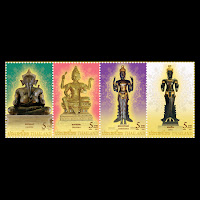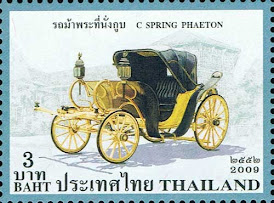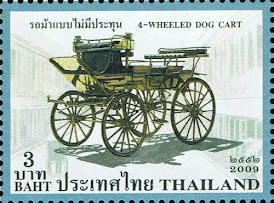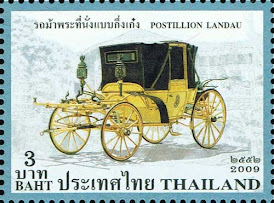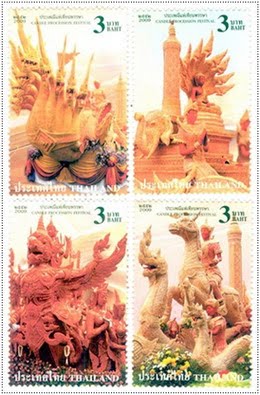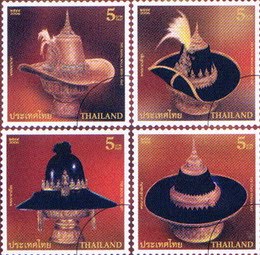
ตราไปรษณียากรชุดรถม้าพระที่นั่ง (Royal Carriage Postage Stamps) พาหนะคู่กษัตริย์จักรีวงศ์ (Vehicles for Thai Monarchs) รถม้าแบบไม่มีประทุน รถม้าพระที่นั่งแบบกึ่งเก๋ง รถม้าพระที่นั่งกูบ รถม้าพระที่นั่งแบบเก๋ง
รถม้าเิริ่มเข้าสู่ประเทศไทยในสมัยกรุงรัตนโกสินทร์ตอนต้น แต่ตอนนั้นไม่แพร่หลายเนื่องจากมีราคาแพง จะมีใช้เฉพาะพระเจ้าแผ่นดินและพระบรมวงศานุวงศ์ชั้นสูงเท่านั้น แต่หลังจากรัชการที่ 5 เสด็จกลับจากยุโรปในปี 2440 ทรงโปรดเกล้าฯ ให้เจ้าพระยาเทเวศร์ วงศ์วิวัฒน์ (ม.ร.ว.หลาน กุญชร) และพระนิเสศพานิช กงศุลสยาม ประจำสิงคโปร์ เป็นผู้จัดหาม้าจากต่างประเทศมาเทียบรถม้าพระที่นั่ง จึงมีการใช้แพร่หลาย และเป็นที่นิยมกันในรัชการที่ 6
ในสมัยรัชกาลที่ 7 และรัชกาลที่ 8 รถม้าได้เริ่มเสื่ือมความนิยมลงเนื่องจากมีค่าใช้จ่ายสูงและรถยนต์ได้เข้ามาแทนที่ มีความสะดวกและดูแลรักษาง่ายกว่า สำหรับรถม้าบนแสตมป์ที่ใช้งานในสมัย รัชกาลที่ 6 และรัชกาลที่ 6 ได้แก่ รถม้าแบบไม่มีประทุน รถม้าพระที่นั่งแบบกึ่งเก๋ง รถม้าพระที่นั่งกูบ รถม้าพระที่นั่งแบบเก๋ง
แสตมป์ชุด : รถม้าพระที่นั่ง
วันจำหน่าย : 7 ตุลาคม 2552
ราคาแสตมป์ : 3 บาท
ผู้ออกแบบแสตมป์ : สุเมธนันตฐ์ ธีรสิทธิรางกูร (บ.ไปรษณีย์ไทย จก.)
ข้อมูลจาก จุลสารข่าวแสตมป์ไทย Vol.4 ตราไปรษณียากร เดือน ตุลาคม - ธันวาคม 2552
23 December 2009
แสตมป์รถม้าพระที่นั่ง
แสตมป์กิจการโทรคมนาคม จัดสรรเส้นทางการสื่อสาร
 ตราไปรษณียากรชุดคณะกรรมการกิจการโทรคมนาคมแห่งชาติ (The National Telecommunications Commission Postage Stamp) จัดสรรเส้นทางการสื่อสาร (Allocation of Communication Routes)
ตราไปรษณียากรชุดคณะกรรมการกิจการโทรคมนาคมแห่งชาติ (The National Telecommunications Commission Postage Stamp) จัดสรรเส้นทางการสื่อสาร (Allocation of Communication Routes)
คณะกรรมการกิจการโทรคมนาคมแห่งชาติ (กทช.) แปรสภาพมาจากกรมไปรษณีย์โทรเลข เป็นองค์การที่มีบทบาทในการบริหารความถี่วิทยุ เพื่อกิจการโทรคมนาคม และกำกับดูแลการประกอบกิจการโทรคมนาคมเพื่อให้เกิดประโยชน์สูงสุดเพื่อประชาชน ทั้งในด้านการศึกษา วัฒนธรรม ความมั่นคงของรัฐ และประโยชน์สาธารณะอื่น ๆ และส่งเสริมให้เกิดการวิจัยและพัฒนาอุตสาหกรรมโทรคมนาคมไทย
ชื่อแสตมป์ : กิจการโทรคมนาคม
วันจำหน่วยวันแรก : 1 ตุลาคม 2552
ราคาแสตมป์ : 3 บาท
ผู้ออกแบบแสตมป์ : ธีรสิทธิรางกูร (บ.ไปรษณีย์ไทย จก.)ม
ที่มา จุลสารข่าวแสตมป์ไทย Vol.4 ตราไปรษณียากร เดือนตุลาคม - ธันวาคม 2552
09 December 2009
เอกลักษณ์ประจำท้องถิ่น

ตราไปรษียากรชุดตราประจำจังหวัด (ชุด 4) Provincial Emblem Postage Stamps (4th Series) - เอกลักษณ์ประจำท้องถิ่น Local Identities
ภูเก็ต - ภาพอนุสาวรีย์สองวีรสตรี หมายถึง วีรกรรมของท้าวเทพกษัตรีและท้าวศรีสุนทร ที่ได้ปกป้องเมืองหลวงให้พ้นจากการรุกรานของพม่า
มหาสารคาม - ภาพต้นไม้ใหญ่และท้องทุ่ง หมายถึง ความร่มเย็นเป็นสุข และมีแหล่งเกษตรกรรมที่อุดมสมบูรณ์
มุกดาหาร - ภาพปราสาท ภายในปราสาทองค์กลางมีแก้วมุกดาหารอยู่บนพาน ใต้พานมีผ้าทิพย์รองรับ
แม่ฮ่องสอน - ภาพช้างในท้องน้ำ หมายถึง การฝึกช้างป่าให้รู้จักการบังคับบัญชาในการรบ และงานด้านต่างๆ
ยโสธร - ภาพสิงห์สองตัวหันหน้าเข้าหาพระเจดีย์ และมีดอกบัวอยู่ใต้ฐาน ภาพสิงห์เป็นสัญลักษณ์ในการสร้างเมืองยโสธร หมายถึง บ้านสิงห์ท่าเดิม กับบ้านสิงห์โคก รูปพระเจดีย์ คือ พระธาตุพระอานนท์ ซึ่งเป็นที่เคารพของชาวยโสธร และรูปดอกบัวเป็นสัญลักษณ์ของจังหวัดอุบลราชธานี ก่อนวันที่ 15 มีนาคม 2515 ซึ่งเดิม จังหวัดยโสธร เป็นอำเภอยโสธร ขึ้นสังกัดกับจังหวัดอุบลราชธานี
ยะลา - ภาพเหมืองแร่ดีบุก หมายถึง พื้นที่ของจังหวัดยะลาอุดมสมบูรณ์ไปด้วยแร่ดีบุก และอาชีพหลัก
ของประชาชนในอดีต คือ การทำเหมืองแร่ดีบุก
ร้อยเอ็ด - ภาพบึงพลาญชัย อันเป็นบึงน้ำใสสะอาดตั้งอยู่กลางเมือง บ่งบอกว่าชาวร้อยเอ็ดมีน้ำใจโอบอ้อมอารี รักสงบ รวมทั้งเป็นแหล่งอาหารที่มีความอุดมสมบูรณ์ ศาลหลักเมือง เป็นที่เคารพสักการะและเป็นศูนย์รวมจิตใจของชาวร้อยเอ็ด มหาเจดีย์ชัยมงคล บ่งบอกถึงความเป็นเมืองแห่งพระพุทธศาสนาที่เจริญรุ่งเรือง ตัวเลข ๑๐๑ แสดงถึงความเป็น เมืองใหญ่ในอดีตที่ชื่อสาเกตนครและเป็นจังหวัดเดียวที่สามารถเขียนชื่อเมืองเป็นตัวเลขได้
ระนอง - ภาพปราสาทตั้งอยู่บนภูเขา มีเลข ๕ ประดิษฐานอยู่บนพานแว่นฟ้า พระบาทสมเด็จพระจุลจอมเกล้าเจ้าอยู่หัว เป็นกษัตริย์องค์แรกที่ประพาสเมืองระนอง ทางจังหวัดได้จัดที่ประทับบนเนินเขานิเวศน์คีรี เลข ๕ คือ รัชกาลที่ ๕ แห่งกรุงรัตนโกสินทร์ ภาพปราสาท คือ พระที่นั่งรัตรังสรรค์ ภูเขา คือ ภูเขานิเวศน์คีรี และพาน คือ ชาวเมืองระนอง
ระยอง - ภาพเกาะเสม็ด ต้นมะพร้าวและพลับพลารัชกาลที่ ๕ เกาะเสม็ดเป็นสัญลักษณ์สำคัญของจังหวัด ตั้งอยู่นอกฝั่งของ ต.เพ อ.เมือง ต้นมะพร้าว แสดงถึงจังหวัดระยองเป็นเกาะที่มีมะพร้าวมาก พลับพลารัชกาลที่ ๕ ด้วยพระบาทสมเด็จพระจุลจอมเกล้าเจ้าอยู่หัว (รัชกาลที่ ๕) โปรดเกล้าฯ ให้สร้างพลับพลาไว้เป็นที่ประทับ ระหว่างเสด็จประพาสบนเกาะแห่งนี้
ราชบุรี - ภาพเครื่องราชกุธภัณฑ์ 2 อย่าง ได้แก่ พระแสงขรรค์ชัยศรี ประดิษฐานอยู่บนบันไดแก้ว และฉลองพระบาทคู่ ประดิษฐานอยู่บนพานทอง ขอบตราเป็นลายกระหนก หมายถึง เครื่องแสดงถึงความเป็นพระเจ้าแผ่นดิน
ชื่อแสตมป์ : ตราไปรษียากรชุดตราประจำจังหวัด (ชุด 4) Provincial Emblem Postage Stamps (4th Series) - เอกลักษณ์ประจำท้องถิ่น Local Identities
วันจำหน่ายแสตมป์วันแรก : 7 กันยายน 2552
ราคาแสตมป์ : 3 บาท (10 แบบ)
ผู้ออกแบบแสตมป์ : อุดร นิยมธรรม (บ.ไปรษณีย์ไทย จก.)
ที่มา แสตมป์ไทย ไปรษณียากรไทย จาก จุลสารข่าวแสตปม์ไทย Thai Stamp Bulletin, Vol. 2009, Issue 3, July-Septembper 2009.
ปฐมบรมกษัตริย์แห่งราชวงศ์จักรี
 ตราไปรษณียากรที่ระลึก 200 ปี แห่งการสวรรคตของพระบาทสมเด็จพระพุทธยอดฟ้าจุฬาโลกมหาราช ZBicentenary of the Demise of King Rama I of the Royal House of Chakri Commemorative Stamp) ปฐมบรมกษัตริย์แห่งราชวงศ์จักรี (The First Monarch of Chakri Dynasty)
ตราไปรษณียากรที่ระลึก 200 ปี แห่งการสวรรคตของพระบาทสมเด็จพระพุทธยอดฟ้าจุฬาโลกมหาราช ZBicentenary of the Demise of King Rama I of the Royal House of Chakri Commemorative Stamp) ปฐมบรมกษัตริย์แห่งราชวงศ์จักรี (The First Monarch of Chakri Dynasty)
ในปลายรัชการลสมเด็จพระเจ้ากรุงธนบุรี ได้เกิดการจลาจลก่อการกบฎ พระองค์ได้ทำการปราบปรามเหตุจราจลได้สำเร็จ แล้วทำการปราบดาภิเภกเป็นพระมหากษัตริย์พระองค์แรกแห่งราชวงศ์จักรี ในวันที่ 6 เมษายน 2325
ทรงสถาปนากรุงรัตนโกสินทร์เป็นราชธานี โปรดเกล้าฯให้สร้างพระบรมมหาราชวังและสร้างราชธานีขึ้นใหม่ และทรงพระราชทานนามราชธานีใหม่นี้ว่า "กรุงเทพมหานครฯ"
พระราชกรณียกิจในระหว่างที่ทรงเถลิงถวัลยราชสมบัติ คือ การแบ่งการปกครองออกเป็น 2 ส่วน คือ การปกครองส่วนกลาง (ราชธานี) และการปกครองส่วนภูมิภาค (หัวเมือง) และทรงบำรุงพุทธศาสนา โดยส่งเสริมพระพุทธศาสนาในหลาย ๆ ด้าน และมีการ "ตรากฎหมายคณะสงฆ์" ออกใช้ เพิ่มมิให้พระภิกษุสงฆ์ประพฤติตนผิดธรรมวินัย
แสตมป์ไทย : พระบรมสาทิสลักษณ์ พระบาทสมเด็จพระพุทธยอดฟ้าจุฬาโลกมหาราช (รัชกาลที่ 1) (Depicting a royal portrait of His Majesty King Buddha Yod Fa Chulalok (King Rama I))
วันจำหน่ายแสตมป์ : 7 กันยายน 2552
ราคาแสตมป์ : 3 บาท
ผู้ออกแบบแสตมป์ : เจนวิทย์ ทองแก้ว (บ.ไปรษณีย์ไทย จก.)
ที่มา ไปรษรียากรไทย แสตมป์ไทย แสตมป์ที่ระลึก จาก จุลสารข่าวแสตมป์ไทย ตราไปรษณียากร เดือนกรกฎาคม-กันยายน 2552 Thai Stamp Bulletin, Vol. 2009, Issue 3, July-September 2009
เปิดตำนานการขนส่งทางอากาศ

ตราไปรษณียากรที่ระลึกวันสื่อสารแห่งชาติ 2552 (National Communications Day 2009 Commemorative Stamp) เปิดตำนวนการขนส่งทางอากาศ (Air Mail Delivery History)
ระบบคมนาคมถือเป็นปัจจัยสำคัญที่ช่วนให้ระบบขนส่งไปรษณียากรเป็นไปอย่างรวดเร็ว ซึ่งในระยะเริ่มแรก ระบบขนส่งยังไม่ทันสมัย ทางบกอาศัย คนแบกหาม หรือใช้เกวียนบรรทุก เรียกว่า "คนเดินเมล์" ส่วนทางน้ำอาศัย เรือกลไฟบ้าง เรือแจวบ้าง เรียกว่า "เรือเมล์" จนกระทั่งในปี 2454 กระทรวงกลาโหมได้นำเครื่องบินมาใช้ใน กิจการทหาร จึงทำข้อตกลงขนส่งถุงไปรษณียากรไปทางอากาศด้วย เรียกว่า "แอร์เมล์"
The trasportation system is essential to the thai Post's ability to deliver mail and goods both accurately and quickly. Early methods to deliver mail included both carts on land as well as boats on water. mail personel were termed "mailman" and "mailboat", respectively. Eventually, the Ministry of Defense brought in military airplanes to deliver mail bags, coining th eterm "airmail".
แสตมป์ไทย ตราไปรษณียากรที่ระลึกวันสื่อสารแห่งชาติ 2552
การขนส่งเมล์ในสมัยโบราณ The Delivery of Mails in the Old Era
วันจำหน่ายวันแรก 4 สิงหาคม 2552
ราคา 3 บาท
พิมพ์จำนวน 1,000,000 ดวง
ผู้ออกแบบ ธเนศ พลไชยวงศ์ (บ.ไปรษณีย์ไทย จก.)
ที่มา ตราไปรษณียากร กรกฎาคม-กันยายน 2552 Thai Stamp Bulletin, Vol.2009, Issue 3, July-September 2009
18 November 2009
การถ่ายทอดชีวิตสู่หุ่นละครเล็ก
 ตราไปรษณียากรที่ระลึกงานแสดงตราไปรษณียากรแห่งชาติ 2552 - Thailand Philatelic Exhibition 2009 Commemorative Stamps - ถ่ายทอดชีวิตสู่หุ่นละครเล็ก Bringing Hun Lakorn Lek to Life
ตราไปรษณียากรที่ระลึกงานแสดงตราไปรษณียากรแห่งชาติ 2552 - Thailand Philatelic Exhibition 2009 Commemorative Stamps - ถ่ายทอดชีวิตสู่หุ่นละครเล็ก Bringing Hun Lakorn Lek to Life22 October 2009
Thai Traditional Festival Postage Stamps

ตราไปรษณียากรชุดประเพณีไทย Thai Traditional Festival Postage Stamps
ประติมากรรมเทียนแห่งธรรม Dharma Candle Sculptures
เมื่อย่างเข้าสู่วันขึ้น 15 ค่ำ เดือน 8 หรือวันเข้าพรรษา พุทธศาสนิกชนมักจะจัดกิจกรรมที่เกี่ยวเนื่องกับวันสำคัญนี้ คือ การจัดประเพณีแห่เทียน พรรษาซึ่งจะจัดกันตามแต่ละท้องถิ่น โดยเฉพาะที่จังหวัดอุบลราชธานีได้จัดงานประเพณีแห่เทียนพรรษาอย่างยิ่งใหญ่มาอย่างต่อเนื่องในช่วงเดือนกรกฎาคมของทุกปีและจุดเด่นของงานนี้ก็คือการประกวดต้นเทียนประเภทต่าง ๆ ประกวดขบวนแห่และนางฟ้า ซึ่งนักท่องเที่ยวทั้งชาวไทยและชาวต่างประเทศเดินทางมาชมความวิจิตรพิสดารของต้นเทียนพรรษา
นับได้ว่าที่จังหวัดอุบลราชธานีแห่งนี้เป็นแหล่งกำเนิดช่างฝีมือระดับบรมครูของประเทศไทยในการแกะสลักเทียนและแกะสลักแบบพิมพ์ติดเทียนที่ผสมผสานนำภูมิปัญญาท้องถิ่นในการแกะสลักเทียนแบบโบราณมาร่วมประยุกต์บรรจงแกะเทียนพรรษาออกมาเป็นงานศิลปะที่งดงาม บ่งบอกถึงความความสำคัญของพุทธศาสนาที่มีอายุล่วงกว่า 2,500 ปี
ข้อมูล แสตมป์ไทย ไปรษณียากรไทย จากจุลสารข่าวแสตมป์ไทย Vol. 2009, Issue 3
Orchid Postage Stamps
 ตราไปรษณียากรชุดกล้วยไม้ Orchid Postage Stamps
ตราไปรษณียากรชุดกล้วยไม้ Orchid Postage Stamps
กล้วยไม้งาม ... นามพระราชทาน
Orchids of Great Beauty and Royal Names
1. กล้วยไม่แคทลียา ควีนสิริกิต์ (Cattleya Queen Sirikit)
2. กล้วยไม้รองเท้านารี พริ้นเซส สังวาลย์ (Paphiopedilum Princess Sangwan)
3. กล้วยไม้เอื้องศรีเชียงดาว (Sirindhornia Pulchella)
4. กล้วยไม้ฟาแลนนอฟซิส พรินเซส จุฬาภรณ์ (Phalaenopsis Princess Chulabhorn)
5. กล้วยไม้หวาย พันธุ์ชมพูนครินทร์ (Dendrobium Pink Nagarindra)
6. กล้วยไม้แอสโคเซ้นดา สุคนธรัศมิ์ (Ascocenda Sukontharat)
7. กล้วยไม้หวาย พันธุ์ โสมสวลี (Dendrobium Soamsawali)
ข้อมูล แสตมป์ไทย ไปรษณียากรไทย แสตมป์กล้วยไม้ จากจุลสารข่าวแสตมป์ไทย Vol. 2009 Issue 3, July-September 2009
01 October 2009
75th Anniversary of Thammasat University Commemorative Stamp
Thai Stamp Name : 75th Anniversary of Thammasat University Commemorative Stamp
Date of Issue : 2009-06-27
Denomination : 3 Baht
เหลืองของเรา คือ ธรรมประจำจิต แดงของเรา คือ โลหิตอุทิศให้
Yellow represents the Laws we hold dear to our heart, Red is the blood representing our devotion to the people
Thammasat University was founded on June 27th, 1934. Its Thai name at birth was the "Wicha Thammasat and Karnmuang University' (the University of Laws and Politics) and its aim was to teach subjects related to the country's administration under a democratic system. It was initially operated as an open university offering an equal right and opportunity to education to all. It became a regular university in 1947 and the word 'Karnmeung' (Politics) was dropped from the university's title in 1952.
The Dome is the University symbol for all students and they often for all students and they often refer to themselves as 'Children of the Dome'. It is a building complex that was adapted from four old military barracks. Roofs were built to connect the four buildings and the centre of the third building became and additional part, decorated with a dome in the middle. The shape of the dome was inspired by an octagonal shape pencil, shapened to a fine point symbolizing how educational administration can sharpen the mind.
Source: Thai Postage Stamp information at Thai Stamp Bulletin, Vol. 2009, Issue 2, April-June 2009
29 September 2009
60th Anniversary of the Philippines-Thailand Diplomatic Relations
Thai Stamp Name : 60th Anniversary of the Philippines-Thailand Diplomatic Relations Commemorative Stamps
Date of Issue : 2009-06-14
Denomination : 3 Baht (2 Designs)
ไข่มุกแห่งบูรพา
Pearl of the Orient
The Philippines Republic consists of a string of islands in the Pacific. It was under the domination of New Spain from 1521 to 1898 and the U.S.A. from 1898 to 1945 of for four cencuries in total. Its culture, therefore, is similar to that of Latin American countries. However, the Spanish influence, when mixed with the Eastern Culture, lends the culture of the Philippines a uniqueness.
Manila is the capital and the major port of the country. Located at the mouth of the Pasig River, it serves as the centre of trade, industry and tourism. When it was still under Spanish rule, the administrative centre, known as Intramuros, was established and it has become a monument created by Spain and, today is one of the tourist attractions of Manila. Other places of interest include the San Agustin Cathedral, the Casa Manila residential area, the Makati shopping Mall and Santiago Fort.
Source: Thai Postage Stamps information at Thai Stamp Bulletin, Vol. 2009, Issue 2, April-June 2009
25 September 2009
Hindu God Postage Stamps
Thai Postage Stamps : Hindu God Postage Stamps
Date of Issue : 2009-06-02
Denomination : 5 Baht (4 Designs)
ผู้เหนืออุปสรรค-ผู้สร้าง-ผู้รักษา-ผู้ทำลาย
The One Who Has Power Over Obstacles-The Creator-The Preserver-The Destroyer
Ganesa
Ganesa, which is another name for Ganesha, means the "God who has power over obstacles". A son of Shiva and Uma, he has the face of an elephant and he was blessed by his father so as to have the power to dispel all obstacles. Offerings must be made to Ganesha before any other gods.
Brahma
Brahma, according to Brahmin Doctrine, is believed to be the Creator of all things on earth. The Musnapurana Legend states that he divided himself into two parts-one being a male figure, which was Brahma himself and the other in female form, named Sraswadee, whoe served as his consort. They helped each other in creating deities, humans, animals, demons and plants.
Narayana
Narayana, also known to the Thais as Phra Narai, is responsible for preserving things in their appropriate condition. His work is continual so as to create peace and harmony in the world. Narai has ten incarnated lives on earth.
Siva
Siva, generally known as Phra Issuan to the Thais, has the duty of destroying all evil things on earth. This god has three eyes and a white complexion. According to traditional Thai belief, Shiva will pay an annual 10-day visit to the earth. This visit will start on the seventh nightof the waning moon in the first lunar month and end on the first night of the waning moon in the same month. During the visit, a Brahmin ceremony, known as the Tri Yumpawai, will be organized to welcome the God.
Source: Thai Postage Stamps information at The Stamp Bulletin, Vol. 2009, Issue 2, April-June 2009
21 September 2009
Important Buddhist Religion Day (Visakhapuja) Postage Stamp
ตราไปรษณียากรชุด วันสำคัญทางพุทธศาสนา (วันวิสาขบูชา)
Thai Postage Stamps : Important Buddhist Religion Day (Visakhapuja) Postage Stamp
Date of Issue : 2009-05-08
Denomination : 3 Baht
จุดกำเนิดการเผยแพร่พระพุทธศาสนา
The Origin of the Dissemination of Buddhism
This postage stamp does not depict incidents related to Visakhapuja Day but it is included in the Visakhapuja postage stamp set because it presents another important incedent that happened after the Lord Buddha had attained Elightenment. The setting is one of the Four Holy Places in the Lord Buddha's Life, where he taugth devout Buddhists to realize the sense of urgency in life so as to understand the life and death cycle and to seek the path that would lead them to the growth of the mind.
The Dhammekka Stupa is a place for Dhamma preaching that will lead to freedom from life's entanglements. It is an ancient stupa in the shape of an alms bowl turned upside down, decorated with a cone-shaped top. The stupa, built in the reign of King Asoka the Great, is approximately 80 feet in height and 120 feet in diameter. It is believed to be the place where the Lord Buddha preached due to Five Disciples one of whom, Konthunya Brahmin, was the first to archive Enlightenment and become ordained the first Buddhist monk. This was used as a place of communion for sixty of the disciples of the Lord Buddha. They were the first group of Buddhist monks who travelled to different parts to disseminate the words of the Lord Buddha.
Source: Thai Postage Stamps information at Thai Stamp Bulletin, Vol. 2009, Issue 2, April-June 2009
17 September 2009
Thai Stamps : Different Styles of the Royal Headgear
Thai Postage Stamps : Different Styles of the Royal Headgear
พระมหามาลา
ลักษณะทรงกระบอก ปีกกว้าง ทำด้วยผ้าตาดสีทอง หลังพระมาลาประดับด้วยยอดการเวก เป็นเครื่องประดับเฉพาะสมเด็จพระมหากษัตริยาธิราชเจ้าเท่านั้น
พระมาลาเส้าสูง
ลักษณะทรงกระบอก ปึกกว้าง ปีกข้างซ้ายพับตลบขึ้น ทำด้วยสักหลาด มีหลายสีตามสีประจำวัน หลังพระมาลวประดับด้วยยอดทองคำรูปพระเกี้ยวยอดหรือจุลมงกุฎ รอบขอบรัด้วยมาลัยรักร้อยกระจังเชิงชายด้ายซ้ายปักพระยี่ก่าทองคำเสียบขนนกการเวก ประดับอัญมณีตามอริยศักดิ์ของบุคคลที่สาม ได้แก่ สีแดงสำหรับพระมหากษัตริย์ และสีเหลืองสำหรับพระบรมวงศานุวงศ์ชั้นสมเด็จเจ้าฟ้า
พระมาลาเบี่ยง
เครื่องราชศิราภรณือันเป็นมงคลยิ่งที่พระบาทสมเด็จพระพุทธยอดฟ้าจุฬาโลกโปรดให้สร้างเลียนแบบพระมาลาองค์เดิมที่พระนเรศวรใช้ทางเมื่อเสร็จในพระราชสงครามยุทธหัตถีกับพระมหาอุปราช และได้สูญหายไปในคราวเสียกรุงศรีอยูธยา พระมาลาองค์ใหม่นี้ทำด้วยไม้ไผ่สานรูปทรงลูกฟักตัด มีปึกคลุมโดยรอบ ลงรักทั้งด้านในและด้านนอก สีดำเป็นมัน ด้านในมี รัง สำหรับทรงสวม ส่วนชั้นนอกสำหรับป้องกันอาวุธ มีที่ว่างระหว่างด้านในพระมาลวกับรังโดยรอบเพื่อช่วยระบายความร้อน ที่ขอบประดับพระพุทธรูปยืนปางอภัยทานองค์หนึ่งกับพระพุทธรูปนั่งปางสมาธิเรียงรายโดยรอบ 21 องค์ ซึ่งมีผู้นำมาทูลเกล้าฯ ถวายพระบาทสมเด็จพระมงกุฎเกล้าเจ้าอยู่หัว และโปรดให้นำมาประดับไว้ในภายหลัง
พระมาลาเพชรใหญ่
ลักษณะทรงมะนาวตัดขอบม้วนกลับเป็นลอนกลม ทำด้วยสักหลาดสีดำประดับเพชร เป็นลายเฟื่องคล้ายเทียรา ตอนบนทำเป็นยอดประดับเพชรกลม ทำเครือเถาประดับเพชรขนาบลงมาทั้งสองข้าง ใต้กรอบเทียราประดับเพชรลายพรรณพฤกษา
Source: Thai Postage Stamp information at Thai Stamp Bulletin, Vol. 2009, Issue 2, April-June 2009
31 August 2009
The Charm of Stone Sanctuaries
Date of Issue: 2 April 2009
Designer: Udorn Niyomthum
The Charm of Stone Sanctuaries
The stone sanctuaries found in Thailand are architectural structures influenced by the Khmer art style. They are generally made of sand stone that is red or off-white in colure. These places once served as religious sanctuaries for Brahmin cermonies performed to respect the gods and they also served as residences for monarchs.
Ta Muean Sanctuary, built of laterite, is believed to have been one of the seventeen residences of King Chaiya Voraman VII. The place consists of a single Prang structure and there is a long gallery linking it with the frontal part.
Ta Muean Thom Sanctuary, is a building complex consisting of three Prang towers made of sandstone. The two Vihara buildings on the compound are made of laterite. This was a place for religious was carved into a Shiva Lingam.
Ta Muean Tot Sanctuary, originally serving as a medical clinic, is made of sandstone and laterite. It is square in shape and decorated with a niche at the front.
Sadok Kok Thom Sancuary or Mueang Phrao Sanctuary, made of sandstone and laterite, is decorated with exquisite motifs. Its interior plan was designed to portray the Universe, depicting the Sumeru Mount in the centre, surrounded by waters, to indicate that this is the most sacred of places.
ชื่อชุด : ตราไปรษณียากรที่ระลึกวันอนุรักษ์มรดกไทย 2552
วันแรกจำหน่าย : 02 เม.ย. 2009
ความมุ่งหมาย : เพื่อเป็นที่ระลึกเนื่องในวันอนุรักษ์มรดกไทยประจำปีพุทธศักราช 2552 และเพื่อส่งเสริมให้ประชาชนได้ตระหนักถึงความสำคัญและเห็นคุณค่าของศิลปะอันล้ำค่าของชาติ
รายละเอียด : ปราสาทหินที่เป็นศาสนสถาน มีองค์ประกอบสำคัญคือปราสาทประธาน เป็นส่วนสำคัญที่สุด เนื่องจากเป็นที่ประดิษฐานรูปเคารพสูงสุด ปราสาทประธานตั้งอยู่ในส่วนที่เป็นศูนย์กลางของผังปราสาท และจะตั้งบนฐานยกพื้นสูงอันมีความหมายถึงการเป็นแกนกลางของจักรวาล
ผู้ออกแบบ(แสตมป์) : นายอุดร นิยมธรรม (บริษัทไปรษณีย์ไทย จำกัด)
บริษัทผู้พิมพ์ : ไทยบริติช ซีเคียวริตี้ พริ้นติ้ง จำกัด (มหาชน) ประเทศไทย
ผู้ออกแบบ(ซอง) : นายอุดร นิยมธรรม (บริษัทไปรษณีย์ไทย จำกัด)
Source: That Stamp Bulletin, Vol. 2009, Issue 2 >> April-June 2009
27 April 2009
The Bi-Centenary Celebrations of H.R.H Krom Luang Wongsa Dhiraj Snid

The Commemorative Stamp : The Bi-Centenary Celebrations of H.R.H Krom Luang Wongsa Dhiraj Snid (แสตมป์ที่ระลึก - ตราไปรษณียากรที่ระลึก 200 ปี พระเจ้าบรมวงศ์เธอ กรมหลวงวงษาธิราชสนิท)
Date of Issue : 30 March 2009
Denomination : 3.00 Baht
Designer : Adisorn Pradit (Thailand Post Co., Ltd.)
The Prince of Medicine
Phra Chao Boromwongthoe Krom Luang Wongsa Dhiraj Snid, ne Phra Ongchao Nuam, was born on July 9th, 1808. This half brother of King Nang Klao Chaoyouthua, or Rama III, served as a physician to the King members of the royal family and high ranking noblemen at the royal court. His work included the compiling of a large number of traditional Thai medicinal ingredients and the classifying of the medicinal properties of herbs following the method of classification practised by Western physicians. He was the first Thai physician to be granted certificates from associations and institutes of medicine, both in Europe and America, and he was invited to become a member of the New York Academy of Medicine.
As well as his knowledge of medicine, the Prince was interested and well versed in literary works. He wrote poetry, one example of which is the second volume of the Chindamanee Proverbial Poems. In the past, his composition was used as a textbook for the sutdy of Thai culture. UNESCO proclaimed him as Important Person for the Year 2008-2009 in the category of Sages and Poets.
Source: Thai Stamp Bulletin, Vol. 2009, April-June 2009
120th Anniversary of the Postal School Commemorative Stamp
ไปรษณียากรไทย แสมป์ไทย ล่าสุด
แสตมป์ไทย แบบต่าง ๆ
- แสตมป์ 100 ปี พุทธทาส
- แสตมป์กรุงเทพฯ เมืองแฟชั่น
- แสตมป์กล้วยไม้
- แสตมป์การเขียนจดหมาย
- แสตมป์ความร่วมมือไทย - สวีเดน
- แสตมป์ความร่วมมือไทย - อิตาลี
- แสตมป์คุณทองแดง
- แสตมป์งานกาชาด
- แสตมป์ชีวิตใต้ทะเล
- แสตมป์ชุดปีใหม่
- แสตมป์ดอกกุหลาบ
- แสตมป์ที่ระลึก
- แสตมป์ที่ระลึก 100 ปี สยามสมาคมในพระบรมราชูปถัมภ์
- แสตมป์ที่ระลึก 30ปี ความสัมพันธ์ทางการทูตไทย-จีน
- แสตมป์ที่ระลึกงานแสดงตราไปรษณียากรแห่งชาติ
- แสตมป์นักษัตรประจำปี
- แสตมป์พระเครื่อง
- แสตมป์พระราชวัง
- แสตมป์เรือพระที่นั่ง
- แสตมป์วันเด็ก
- แสตมป์วันพุทธศาสนา
- แสตมป์วันสงกรานต์
- แสตมป์วันสำคัญทางพุทธศาสนา
- แสตมป์วันสื่อสารแห่งชาติ
- แสตมป์อนุรักษ์มรดกไทย
แสตมป์ไทย อดีต-ปัจจุบัน
คนคิดแปลก มองมุมต่าง
Copyright © 2009 แสตมป์ไทย | Fresh Themes Gallery | NdyTeeN. All Rights Reserved. Powered by Blogger and Distributed by Blogtemplate4u .

 more
more


